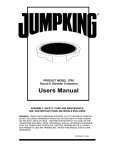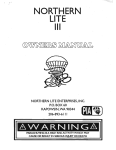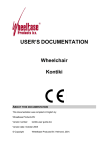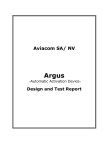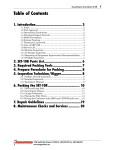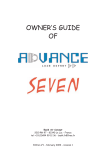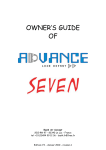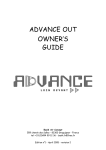Download Canopy Owners Manual October 2003 working.vp
Transcript
SERIAL # RAM AIR CANOPY OWNERS MANUAL Tandem Main & Reserve, BlackHawk Main & Reserve, NightHawk Main & Reserve AngelFire Reserve, Mentor, Basix, FireBolt PARACHUTE LABORATORIES INC. d.b.a. JUMP SHACK 1665 LEXINGTON AVE. SUITE 106 DELAND, FL. USA 32724 Tan dem Main & Re serve, Black Hawk Main & Reserve, Night Hawk Main & Reserve, Angel Fire Reserve, Men tor, Ba six & FireBolt Own ers Man ual Table of Contents GENERAL . . . . . . . . . . . . . . . . . . . . . . . . . . . . . . . . . . . . . . 3 FIREBOLT MAIN CANOPY . . . . . . . . . . . . . . . . . 7 INTRODUCTION . . . . . . . . . . . . . . . . . . . . . . . 3 ASSEMBLY . . . . . . . . . . . . . . . . . . . . . . . . . . . . . . . . . . . . . 8 WARNING . . . . . . . . . . . . . . . . . . . . . . . . . . . 3 PARTS LIST . . . . . . . . . . . . . . . . . . . . . . . . . . 8 DISCLAIMER . . . . . . . . . . . . . . . . . . . . . . . . . 3 CANOPY ASSEMBLY . . . . . . . . . . . . . . . . . . . . 8 ABOUT THE MANUAL. . . . . . . . . . . . . . . . . . . . 3 TANDEM CANOPY ASSEMBLY . . . . . . . . . . . . . . 9 COPYRIGHTS . . . . . . . . . . . . . . . . . . . . . . . . . 3 FIREBOLT ASSEMBLY . . . . . . . . . . . . . . . . . . . 9 SERIAL NUMBER . . . . . . . . . . . . . . . . . . . . . . . 4 SPECIFICATIONS . . . . . . . . . . . . . . . . . . . . . . . . . . . . . . 10 TECHNICAL DATA . . . . . . . . . . . . . . . . . . . . . . 4 ANGELFIRE, NIGHTHAWK &BLACKHAWK OPERATIONAL LIMITATIONS . . . . . . . . . . . . . . . . . . . 5 SPECIFICATIONS . . . . . . . . . . . . . . . . . . . . . . 10 CYCLIC INSPECTIONS . . . . . . . . . . . . . . . . . . . 5 FIREBOLT SPECIFICATIONS . . . . . . . . . . . . . . . 11 PERSONNEL QUALIFICATIONS . . . . . . . . . . . . . . 5 INSPECTION INSTRUCTIONS . . . . . . . . . . . . . . . . . . 12 MAINTENANCE &REPAIR PROCEDURES . . . . . . . 5 GENERAL. . . . . . . . . . . . . . . . . . . . . . . . . . . 12 OPERATIONAL CHARACTERISTICS . . . . . . . . . . . . . 7 VISUAL INSPECTION . . . . . . . . . . . . . . . . . . . 12 ANGELFIRE / NIGHTHAWK RESERVES . . . . . . . . . 7 RESERVE PACKING INSTRUCTIONS. . . . . . . . . . . . 14 BLACKHAWK RESERVE . . . . . . . . . . . . . . . . . . 7 CRITICAL POINT: . . . . . . . . . . . . . . . . . . . . . . . . . . 14 SSE001 OCTOBER 2003 Page 1 of 17 Tan dem Main & Re serve, Black Hawk Main & Re serve, Night hawk Main & Re serve, AngelFire Reserve, Men tor, Ba six & FireBolt Own ers Man ual GENERAL INTRODUCTION Congratulations on the purchase of your new main or reserve canopy from Jump Shack. As you put jumps on your new canopy and get to know it, you will come to realize that you have purchased the most reliable parachute that money can buy. We are sure that it is the most thoroughly engineered canopy available. All of our canopies have been designed using 3-dimensional CAD technology. This manual introduces you to your new Racer Tandem Main or Reserve, AngelFire Reserve, BlackHawk Main or Reserve, NIGHTHAWK Main or Reserve, Basix, Mentor or FireBolt - an introduction you must have before taking to the air with it. So leave yourself plenty of time between getting the canopy and making the first jump on it. Use this manual to help familiarize yourself with your complete system. WARNING IT IS ASSUMED THAT INTENTIONALLY JUMPING FROM AN AIRPLANE IN FLIGHT OR FROM A FIXED OBJECT IS DANGEROUS TO LIFE AND LIMB. PARACHUTES DO NOT ALWAYS WORK AS DESIRED. WHEN YOU TAKE IT UPON YOURSELF TO PARTICIPATE IN PARACHUTE JUMPING, YOU ACCEPT THE FACT THAT NO MATTER HOW CAREFUL YOU ARE, OR HOW GOOD YOUR EQUIPMENT IS, YOU CAN BE SERIOUSLY OR FATALLY INJURED. DISCLAIMER It is expressly understood and agreed between the seller and the buyer and any subsequent user of this parachute, all or in part, the manufacturer and seller shall in no way be deemed or held liable or accountable for any failure or damages resulting from failure of the product. Use of this product for SSE001 OCTOBER 2003 any purpose shall constitute waiver to the manufacturer and seller for any damages to person or property directly or indirectly caused by said use. This parachute is sold with all faults and without fitness for any particular purpose, and the manufacturer neither implies nor expresses any warranties or guarantees of the parachute. Use of this parachute for any purpose constitutes agreement between the buyer or user and the seller according to the terms herein. If the buyer refuses the terms of this agreement, he must return the unused parachute to the manufacturer with 10 days of receipt of the parachute with a letter stating why the parachute was returned along with the accompanying invoice showing purchase price. ABOUT THE MANUAL We have tried to write this manual, for all Jump Shack canopies. However, it is only current for the serial number shown on the first page. The data contained herein was current at the time of this writing, but the sport advances rapidly. Some of this information may not be true now or especially as time goes on. We reserve the right to change the canopy and its procedures without notice. Prudence requires that you contact us for information on updates if you are using this manual as a guide to service a later generation Jump Shack canopy. Additionally, you may view the most recent version of the Owners Manual at our Internet site: WWW.JUMPSHACK.COM COPYRIGHTS Jump Shack holds all copyrights to this manual. We grant permission to anyone to reproduce it all or in part for non-commercial purposes. No reproduction of this manual may be sold anywhere without a royalty agreement with Jump Shack. Anyone copying this manual for distribution must do so without charge, excepting the cost of reproduction. Page 3 of 17 Tan dem Main & Re serve, Black Hawk Main & Re serve, Night hawk Main & Re serve, AngelFire Reserve, Men tor, Ba six & FireBolt Own ers Man ual SERIAL NUMBER The first two digits of the serial number denote the week of manufacture. The third digit denotes the year. The last two digits denote the sequence. Caution: This manual is serial numbered corresponding to the canopy with which it was shipped. Technical information in this manual refers only to the canopy of that same serial number. Record the information from the data plate now, along with the colors of your canopy, in case your gear becomes lost or stolen. Keep the record some place other than your equipment bag. If you have any question regarding your canopy, this manual, or the procedures described in the manual, contact: Jump Shack 1665 N. Lexington Ave. #106 DeLand, Florida 32724 USA TEL (386) 734-5867 FAX (386) 734-8464 TECHNICAL DATA These Reserve Parachutes are approved under one of the following: Part number SST202 7-Cell Reserve has been certificated in the Low Speed Category by the Federal Aviation Administration (FAA) under Technical Standard Order (TSO) C-23(b). It is limited to use in Aircraft under 150MPH. It is additionally limited to use with less than 225 pounds. This TSO refers to National Aircraft Standard (NAS) 804 published in September, 1949. The 9-Cell and 11-Cell Tandem Reserve are Certified under TSO-C23©) this TSO refers to AS8015a published September 30, 1982. To meet these requirements, the manufacturer must submit the design in drawings to the FAA Engineering District Office. The FAA then inspects and certifies the manufacturing facility and approves the quality control of the manufacturing process as described in the manufacturer’s manual. SSE001 OCTOBER 2003 The FAA further assures that the manufacturer will trace and inspect each piece of fabric and hardware he uses during the manufacturing process of the equipment. Under TSO C-23(b), equipment can be tested to Standard Category (sometimes called High Speed) or Low Speed Category. A rig may be assembled with a Low Speed Category reserve canopy, but then the entire system becomes certificated in the Low Speed Category. (Later installation of a Standard Category canopy restores the system to the Standard Category). Regulations require the rigger to identify the system as Low Speed Category in the appropriate manner when he installs a reserve from that category. Standard Category requires no markings. Performance limitations of the installed canopy should be placarded, in the manner required by the TSO document, for the user’s information. The 9-Cell and 11-Cell reserves certified under TSO C23©) must conform to AS-8015a . The test weight and speed specified in AS-8015a Category B is 300 Lbs. @ 175 KTS. The Tandem Reserve canopies have been tested to 625 LBS. @ 175 KTS. Part numbers 12120 & 12121. 9 cell reserves of 300 & 265 sq. Ft. Respectively, have been approved under TSO C-23d which requires conformance to AS-8015b. They are approved for use in dual (main & reserve) containers and are limited to use at 254 lbs. At 150 kts. Additionally, the series of 7 cell reserves, P/N’s 11001 thru 110010 have been certified under TSO C23(d) and meet the requirements of AS8015c. Their limitations are listed on page 7 of this manual. Structural tests of these canopies were performed using a “SPEED” Bag. This is a deployment bag which is designed to absolutely prevent “Line Dump” or out-of-sequence deployment. Assembling riggers who are mixing components under Part 105 assume the responsibility of assuring canopy/bag compatibility in order to maintain structural integrity. Page 4 of 17 Tan dem Main & Re serve, Black Hawk Main & Re serve, Night hawk Main & Re serve, AngelFire Reserve, Men tor, Ba six & FireBolt Own ers Man ual OPERATIONAL LIMITATIONS CYCLIC INSPECTIONS The Federal Aviation Administration requires that all parachute systems in use for emergency circumstances be inspected every 120 days. You, as the user of this equipment, should be familiar with and check these items. PERSONNEL QUALIFICATIONS Only a currently FAA licensed rigger may assemble, inspect, pack, and certify a reserve as airworthy within the United States. Riggers are required to have this manual available to them while servicing this canopy. Per the FAA regulations you must be familiar with any type of reserve parachute you wish to certify. The main canopy and its accessories may be assembled and packed by you or a licensed rigger. The FAA states that minor repairs may be done by a Senior Rigger and major repairs must be done by a Master Rigger. They further define minor repairs as anything that does not affect the airworthiness of the equipment, and major repairs as anything that does affect the airworthiness. This regulation/policy SSE001 OCTOBER 2003 is subjective and open to discussion. You as the owner and your rigger should discuss the required repair and make the best decision you can. If there is still some question call us. Usage of these products outside of the United States is governed by the regulation of that country or Military Organization. MAINTENANCE &REPAIR PROCEDURES The best guide for the execution of general repairs to be performed on parachutes is “The Parachute Manual” by Poynter. When performing periodic inspection to your canopy the relative line lengths should be noted. A differential of more than one inch should be cause for rejection and subsequent correction before return to service. Any broken fibers or threads should be repaired or replaced. Stains must be identified and documented. They should be removed if possible without damaging the fabric. Generally only acidic entities are harmful to nylon therefore a pH test is an appropriate method of determining if a stain is harmful. Page 5 of 17 Tan dem Main & Re serve, Black Hawk Main & Re serve, Night Hawk Main & Re serve, Angel Fire Reserve, Men tor, Ba six & FireBolt Own ers Man ual OPERATIONAL CHARACTERISTICS ANGELFIRE / NIGHTHAWK RESERVES The AngelFire and NightHawk reserves are both 7 Cell Ram-Air, rectangular plan form parachutes. The specification and weight limitations may be found in the "Specifications" Chapter. These canopies come standard with 1000 pound test Spectra suspension line. Both canopies have been designed in a 3D CAD environment to provide improved reliability and durability. They were structurally tested using a positive locking stow deployment bag which was designed to prevent line dump. Line dump can be severe enough to cause structural failure during deployment. Therefore these canopies should be employed with deployment devices of equal capability. BLACKHAWK RESERVE The BlackHawk is a 9 cell Ram-Air rectangular plan form parachute. The specification and weight limitations may be found in the "Specifications" Chapter. This canopy comes standard with 1000 pound test Spectra suspension line. It was structurally tested using a positive locking stow deployment bag which was designed to prevent line dump. Line dump can be severe enough to cause structural failure during deployment. Therefore this canopy should be employed with deployment devices of equal capability. FIREBOLT MAIN CANOPY The FireBolt main canopy is a 9-cell, true elliptical plan form ram-air parachute. It is a truncated 3 to 1 ellipse resulting in a 2.65 to 1 aspect ratio. It is fitted with "Sharks Teeth" on the leading edge. The Sharks Teeth are contoured to provide an improved leading edge entry section of the airfoil locally at the load rib. It has a dual steering line setup. The SSE001 OCTOBER 2003 outboard line is braked for deployment but the inboard is not. It comes with 500 pound test Spectra suspension line which is assembled without stitching the lines. The lines are threaded back through the finger trap insert, locking the finger trap. Using this method they can be disassembled and adjusted in the field without a sewing machine. The FireBolt is absolutely new technology, and really can’t be compared directly to any other canopy. When lightly loaded (.5 or .6 pounds per sq. ft.), it can be a beginner canopy. When heavily loaded (2.3 pounds per sq. ft. to 1.7 pounds per sq. ft.) it is a high performance canopy that will easily out swoop a Stiletto or other pseudo semi-elliptical canopy. When loaded from .85 pounds per square foot to 1.6 or so, it is a great all-around canopy, capable of slow flight with lots of stability and great toggling range. It was created in 3-D, so the dimensions of the skins and lines lengths are extremely accurate, and the characteristics were completely predictable. So when you ask “what can it be compared to?” the answer is: Triathlon when lightly loaded, Stiletto/Spectre/Icarus Crossfire when loaded “mid weight”, and Icarus Extreme/Velocity when heavily loaded. Yes, it’s really that versatile and it’s available in 16 sizes from 75 to 396 square feet! While the FireBolt plan form is new to Ram Air parachutes it is not new to aeronautics. It has long since been known that the fully elliptical wing is the most efficient. While there have been previous attempts to utilize this most desirable of wing forms they have resulted in compromise because of design stumbling blocks. This new technology is accomplished though the use of 3D modeling in a CAD system. It is not so much as what we did but how we did it. How we approached the design task. It took over two years and hundreds of test jumps to achieve all of the goals set out in the design challenge. Page 6 of 17 Tan dem Main & Re serve, Black Hawk Main & Re serve, Night hawk Main & Re serve, AngelFire Reserve, Men tor, Ba six & FireBolt Own ers Man ual ASSEMBLY PARTS LIST Canopy with Attached Lines Connector Links Rubber Stow Bands Note: Only U.S. Military Specification R-1832 rubber stow bands may be used on Parachute Labs. Products. They are available from Jump Shack. CANOPY ASSEMBLY loading or density altitude. Locate the toggle mark on the control line. Insert the finger trap tool beyond this mark, far enough away to accept the running end inside the line and exit at the mark. Make a loop with approximately 2" circumference and fingertrap. The idea is to use the width of the toggle as a measuring guide for the size of the loop.It should be just long enough to go around or over the toggle. A. Connect the canopy to the reserve risers using appropriately sized Rapide links. For Rapide links, turn under the edge of the riser webbing to buffer itself and install the links. Turn the barrel nuts until snug plus one-quarter turn. Instructions For Spectra Line B. Route the steering line through the guide ring on the riser. You may use the factory supplied mark for the toggle location or you may locate the toggle per your requirements. Remember the desired toggle location may change with pound per square foot C. Pull the finger trapped line through it's self , about a half inch from the junction. We do this twice, about 1 inch apart for to assure engaguement of the core line. Never tie a knot in or burn Spectra. D. Next slide the loop thru the toggle grommet and over the toggle. The locator mark on the line should be just to the outside of the loop, away from the toggle. E. Pull the loop up to the grommet. SSE001 OCTOBER 2003 Page 7 of 17 Tan dem Main & Re serve, Black Hawk Main & Re serve, Night hawk Main & Re serve, AngelFire Reserve, Men tor, Ba six & FireBolt Own ers Man ual Instructions for Dacron or Polyester line. A. Route the steering line through the guide ring on t he riser. Then route it through the grommet in the toggle, starting from the Velcro side. B. Then route the steering line around the toggle on t he right side and then back through the grommet. C. Now route the steering line around the toggle on the left side and then back through the grommet. D. Adjust the line so that the toggle mark is on the line exiting the grommet going to the canopy, at the base of the grommet, on the Velcro side of the toggle. Pull out all the slack while maintaining the toggle mark position. E. Tie an overhand knot in the steering line and cinch it down against the toggle. SSE001 OCTOBER 2003 TANDEM CANOPY ASSEMBLY All canopies should have a rubber stow band attached to the line attachment point of one of the inboard “C” lines. The center of the slider should be stowed in this retainer during packing. The purpose of this retainer is to prevent the slider from coming down the lines prematurely. It is a good idea to do this to any canopy. Other canopies may require that the stow band be located on the “B” line. This may be determined by pulling the center of the slider up into the center of the air channel with the slider grommets firmly against the slider stops. Observe where the point 3 to 4 inches from the center point of the slider falls, and locate the stow band on the nearest line attachment point. FIREBOLT ASSEMBLY FireBolts are equipped with two (2) steering lines on each side. The outboard line is braked during deployment but the inside set is not. Both are attached to the toggle. All FireBolts use Spectra line therefore the Spectra line instructions for toggle assembly should be followed. Simply engage both lines simultaneously during assembly. Page 8 of 17 Tan dem Main & Re serve, Black Hawk Main & Re serve, Night Hawk Main & Re serve, Angel Fire Reserve, Men tor, Ba six & FireBolt Own ers Man ual SPECIFICATIONS ANGELFIRE, NIGHTHAWK &BLACKHAWK SPECIFICATIONS Canopy & P/N Cells Sq. Ft. Chord Span Aspect Peak Force Pack Volume AngelFire 97 P/N 11001 7 97 6.5’ 15.5’ 2.32 3465 286 Cu. In. AngelFire 114 P/N 11002 7 114 6.9’ 16.0’ 2.32 3465 312 Cu. In. AngelFire 125 P/N 11003 7 125 7.8 17.5’ 2.32 3465 312 Cu. In. AngelFire 150 P/N 11004 7 150 8.3 18.0’ 2.32 3465 390 Cu. In. AngelFire 180 P/N 11005 7 180 9.25’ 19.5’ 2.32 3465 416 Cu. In. AngelFire 200 P/N 11006 7 200 9.75’ 20.6’ 2.32 3465 468 Cu. In. AngelFire 228 P/N 11007 7 228 10.4’ 22.0’ 2.32 3465 520 Cu. In. AngelFire 245 P/N 11008 7 245 10.8’ 22.75’ 2.32 3465 546 Cu. In. AngelFire 280 P/N 11009 7 280 11.5’ 24.3’ 2.32 3465 598 Cu. In. AngelFire 300 P/N 110010 7 300 11.9’ 25.2’ 2.32 3465 702 Cu. In. NightHawk 245 P/N 11008NH 7 245 10.8’ 22.75’ 2.32 3465 546 Cu. In. NightHawk 280 P/N 11009NH 7 280 11.5’ 24.3’ 2.32 3465 598 Cu. In. NightHawk 300 P/N 110010NH 7 300 11.9’ 25.2’ 2.32 3465 702 Cu. In. BlackHawk 265 P/N 12121 9 265 10.1’ 26.8’ 2.65 3692 580 Cu. In. BlackHawk 300 P/N 12120 9 300 10.75’ 28.5’ 2.65 3600 702 Cu. In. LINE TRIM SPECIFICATIONS A to B A to C A to D AngelFire 97 P/N 11001 2.2” 7.3” 14.5” AngelFire 114 P/N 11002 2.3” 7.9” 15.6” AngelFire 125 P/N 11003 2.5” 8.3” 16.4” AngelFire 150 P/N 11004 1.6” 7.2” 15.8 AngelFire180 P/N 11005 2.2” 8.2” 17.7” AngelFire 200 P/N 11006 2.4” 8.8” 18.5” AngelFire 228 P/N 11007 2.6” 9.6” 20.1” AngelFire/NightHawk 245 P/N 11008 2.5 9.5” 20.4” AngelFire/NightHawk 280 P/N 11009 2.7” 10.2” 21.9” AngelFire/NightHawk 300 P/N 110010 2.8” 6.8” 18.9” BlackHawk 265 P/N 12121 2.75” 9.15” 18.9” BlackHawk 300 P/N 12120 2.75” 9.3” 19.3” SSE001 OCTOBER 2003 Page 9 of 17 Tan dem Main & Re serve, Black Hawk Main & Re serve, Night Hawk Main & Re serve, Angel Fire Reserve, Men tor, Ba six & FireBolt Own ers Man ual FIREBOLT SPECIFICATIONS In the table below the left column identifies the following items in order; part number, square footage , Average Cord, and Span, The numbers presented were derived using the inflated plan form method. In the remaining column the letters are for the lines attachment at the rib attachment points A=Nose etc.. The numbers after the letters represent the ribs to which the lines are attached with 1 being the inboard center and 9 being the wing tip. A1 in given in actual inches all others are the differential from the inboard nose P/N 12221 12222 12223 12224 12225 12226 12227 12228 12229 12230 129902 Sq Ft 75 92 110 128 146 164 182 200 236 300 396 Chord 5.32 5.91 6.44 6.94 7.4 7.87 8.31 8.68 9.42 10.61 12.19 Span 14.09 15.67 17.08 18.37 19.73 20.83 22.01 22.99 24.96 28.1 A1 89.3 99.7 108.4 115.9 124.7 132.2 139.9 146.0 158.5 178.5 206.5 A3 0.0 -0.1 0.0 0.0 0.0 0.0 0.1 0.0 0.0 0.0 -0.1 A5 -0.6 -0.1 0.0 -0.1 -0.1 -0.1 -0.2 0.0 -0.1 -0.1 -0.3 A7 -0.4 0.0 0.0 0.0 -0.2 0.0 -0.2 0.0 0.0 0.0 -0.3 A9 0.2 0.2 0.3 0.3 0.3 0.3 0.3 0.3 0.4 0.5 0.1 B1 1.3 1.4 1.5 1.6 1.7 1.8 1.9 2.0 2.2 2.5 2.8 B3 1.3 1.5 1.6 1.7 1.8 1.9 2.0 2.1 2.3 2.6 2.9 B5 0.8 1.5 1.7 1.8 1.9 2.0 2.1 2.4 2.4 2.7 3.0 B7 1.1 1.7 1.9 2.0 2.5 2.3 2.3 2.6 2.7 3.0 3.3 B9 1.8 2.0 2.2 2.4 2.5 2.7 2.9 3.1 3.2 3.6 3.9 C1 5.3 6.0 6.5 6.9 7.5 7.9 8.2 8.7 9.5 10.7 12.0 C3 5.3 5.9 6.4 6.8 7.4 8.6 8.0 8.6 9.4 10.5 11.8 C5 5.2 5.7 6.3 6.7 7.2 7.6 7.9 8.4 9.2 10.3 11.6 C7 6.8 7.6 8.4 5.6 6.0 6.4 6.5 7.0 7.6 8.6 9.6 C9 6.3 7.0 7.6 4.8 5.2 5.5 5.6 6.1 6.6 7.4 8.2 D1 11.6 13.0 14.1 8.7 16.2 17.2 18.0 19.0 20.6 23.2 26.4 D3 11.3 12.6 13.7 8.2 15.8 16.7 17.5 18.5 20.0 22.6 25.7 D5 10.8 12.0 13.1 7.6 15.1 16.0 16.7 17.6 19.1 21.5 24.5 D7 N/A N/A N/A 6.5 7.0 7.4 7.6 8.1 8.8 9.9 11.1 D9 N/A N/A N/A 6.2 6.6 7.2 7.2 7.7 8.4 9.5 10.6 S4 24.7 25.8 26.2 31.4 32.8 35.0 31.6 34.7 35.4 39.7 29.0 S5-6 22.2 23.7 23.7 28.9 30.4 32.1 28.0 31.5 31.9 36.0 64.0 S7-9 22.2 24.4 23.7 28.9 30.4 32.1 31.0 30.5 35.4 39.9 47.5 Braked 2.2 2.2 8.7 2.4 2.4 2.3 8.6 8.0 10.0 11.3 16.0 32.49 line. "S" is for Steering lines and the number is the rib to which it is attached. "Braked" is the same as S7-9 w/brakes set. Note: Tandem 396 has 7 steering lines, 4 outboard, braked, 3 inboard. S7-9 = S6-9, S5-6 = S4-6. SSE001 OCTOBER 2003 Page 10 of 17 Tan dem Main & Re serve, Black Hawk Main & Re serve, Night Hawk Main & Re serve, Angel Fire Reserve, Men tor, Ba six & FireBolt Own ers Man ual INSPECTION INSTRUCTIONS GENERAL Your Parachute Labs reserve must be inspected thoroughly at the time of its initial assembly and at every Inspect & Re-pack Cycle.The preferred method of inspecting your ram air parachute is to hang the parachute up by the tail so that you can see the entire top and bottom skin. This will make the line continuity check easier too. Clamps attached to a spreader bar that is at least the width of the canopy make this job a cinch. An FAA certificated rigger must inspect your new Parachute Labs reserve and determine its compatibility with your rig. The inspection should be done in a clean, well lit area that will allow the canopy to be completely spread out. VISUAL INSPECTION It’s best to inspect your reserve in a careful, systematic way. We recommend starting at the top of the canopy and working down to the risers as described below: 1. TOP SURFACE: Hang the canopy or spread the canopy out on its bottom surface and inspect the top surface starting at the front of the left end cell. Check half of the cell from nose to tail. Then check the other half cell going tail to nose. Repeat this pattern until all the cells top surfaces are inspected. Look for rips, stains, or failed seams. 2. BOTTOM SURFACE: Again use the procedure of inspecting half cells as on the top surface. Check for rips, stains and failed seams. Look very closely at the line attachments. Even slight damage is cause for rejection in these areas. Line attachments must be completely free of any damage or defects. 3. RIBS: From leading edge to the trailing edge by looking inside each cell. Pay extra attention to the line attachment points. 4. LINES: Check that all lines in each line group are the same length and that the trim differential between each line group is correct for this reserve. This can be done while the canopy is in the hanging SSE001 OCTOBER 2003 position or with the canopy neatly laid out on its side. Check the condition of the stabilizers and slider stops on the stabilizer. Elliptical canopies have a slight differential of line length within the group from inboard to outboard. Consult the specifications chapter for details. 5. TRIM: Check the full length of each line for damage and wear. Look for fraying at all cascades and where each line attaches to the connector link. Check that all lines are sewn and that the stitching is good. Check the continuity and routing of each line. The FireBolt canopies employ a "Stitchless" method of locking the finger trap in place. Therefor there are no stitches to inspect. 6. SLIDER: Be sure the fabric isn’t torn, that the grommets are undamaged and have no sharp edges, and that they are securely attached to the slider. Be sure every suspension line and both steering lines pass through the proper grommet on the slider. 7. RISERS & LINKS: Be sure the barrels of the connector links have not moved by checking the match marks. Visually check the match mark and link condition. If the match mark is still intact and the link is not bent or damaged, the link is OK for continued service. If the upper and lower parts of the mark become misaligned, then the barrel has shifted. Should this happen, the link must be immediately disassembled, cleaned and inspected. If no damage has occurred, the riser/link/line/slider bumper assembly may be reattached . Ensure that the slider bumpers located on the connector links are the correct ones, are positioned correctly, and are properly tacked to the links. The toggles must be installed correctly and must match the guide ring and Velcro or snaps on the risers. Parachute Labs canopies come with brake settings and toggle tie-on marks set for PIA standard riser/brake dimensions. This standard calls for 4 inches (10.2 cm) from the top of the riser to the top of the brake-setting ring. If there is a differential of more than 1 inch (2.5 cm), from this standard the Page11 of 17 Tan dem Main & Re serve, Black Hawk Main & Re serve, Night Hawk Main & Re serve, Angel Fire Reserve, Men tor, Ba six & FireBolt Own ers Man ual canopy must be modified. This modification may only be done by a master rigger and must be reported to Parachute Labs, Inc. In addition, any changes must be marked on the canopy’s data panel. 8. THE REST OF THE ASSEMBLY: Follow the instructions in the harness/container manufacturer’s SSE001 OCTOBER 2003 owners manual to inspect the rest of your parachute system. Page 12 of 17 Tan dem Main & Re serve, Black Hawk Main & Re serve, Night Hawk Main & Re serve, Angel Fire Reserve, Men tor, Ba six & FireBolt Own ers Man ual RESERVE PACKING INSTRUCTIONS CRITICAL POINT: B. Hold all the lines in one hand while standing, Compatibility—Make sure the canopy you’re packing is the right size for the rig it’s connected to. Even if it was in there before, someone else’s mistake will become yours when you sign the packing data card. SETTING BRAKES : A. Pull the steering line through the guide ring mounted on the riser down to the eyelet provided in the steering line. B. Fold the excess in half and insert through slot in top of riser. Note: A special brake stow loop has been provided and organize the nose. It should now face the con- in the top rear of the riser. This loop is for routing the excess steering line. (See Photograph) C. Place the loop made by the excess over and in line with the brake eyelet. D. Insert the toggle through the loop in “C.” and then through the brake eyelet. E. Insert the toggle into it’s elastic keeper and seat it to the mating velcro on the riser. Note: The Firebolt has dual steering lines and only the outboard set is braked for deployment. FOLDING CANOPY: A. Separate the four line groups below the slider and walk the slider up toward the canopy while lifting the canopy off the floor. Seat the slider grommets against the slider stops. SSE001 OCTOBER 2003 tainer. With “HANDS ON” trace and clear the perimeter Page 13 of 17 Tan dem Main & Re serve, Black Hawk Main & Re serve, Night Hawk Main & Re serve, Angel Fire Reserve, Men tor, Ba six & FireBolt Own ers Man ual of the canopy pulling all stabilizers toward the outside of the bundle. NOTE: This process is similar to the flaking of a round canopy and must be done with care as panels not cleared could cause a malfunction. C. Place the center tab of the tail under your thumb as shown D. Sweep your forearm under the nose of the canopy and lay it on the floor. The bundle will spread out widely, but neatly. E. Kneel at the top of the canopy facing the container. Draw the canopy toward you while at the SSE001 OCTOBER 2003 same time narrowing the bundle to the width of the bag. Constantly work the fabric away from the links. F. Pull the center tab of the tail to the top exposing the air channel. G. Fold one-half of the tail over the bundle to in- spect the stabilizer folds. Dress the tail, stacking all Page 14 of 17 Tan dem Main & Re serve, Black Hawk Main & Re serve, Night Hawk Main & Re serve, Angel Fire Reserve, Men tor, Ba six & FireBolt Own ers Man ual chord seams neatly over the center line (air channel) and neatly lay all stabilizer and tail fabric to the outside. Repeat with other half of tail back to the center. Stow the slider in its rubber band. H. Return the center tail tab to the bottom center of the bundle. Where the stabilizers attach to the main I. Fold the exposed stabilizers back under the tail. Lay your hand 6"-8" from the bottom of the bundle and fold the canopy back over itself. J. Fold each section of the nose outward from the center so it takes air quickly during deployment. body of the canopy. “Cocoon” the canopy to the K. Fold the canopy back over so you now have an width of the bag. NOTE: Care must be taken during the cocooning process so as not to disturb the air channel and lines of the canopy. 8" S-fold at the bottom. The length and number of S-folds may vary according to the distance between the vertical partition that separates the main and re- SSE001 OCTOBER 2003 Page 15 of 17 Tan dem Main & Re serve, Black Hawk Main & Re serve, Night Hawk Main & Re serve, Angel Fire Reserve, Men tor, Ba six & FireBolt Own ers Man ual serve containers, and the grommet in the bottom PLACING CANOPY INTO BAG: A. Face away from the container and kneel on the packed canopy to keep it under control. Shape the bundle to resemble the bag, prepare the bag and install the canopy into it. The canopy must be folded to mimic the length, width and thickness of the container. flap of the reserve container. L. Tuck the remainder of the canopy under the bundle until it is the height of the bag. SSE001 OCTOBER 2003 Page 16 of 17 Tan dem Main & Re serve, BlackHawk Main & Re serve, Night Hawk Main & Re serve, AngelFire Re serve, Men tor, Basix & FireBolt Own ers Man ual PERMANENT HISTORY RECORD Container Serial # Main Canopy Serial # Date of Mfg. Date of Mfg. Rsv. Canopy Serial # Main Color Date of MFG. Rsv. Color This page provides a place for you to keep a permanent history record of your canopies. You as the owner of this parachute system should provide this manual to your rigger at the inspection/re-pack interval and they should fill out this page in addition to the Packing Data Card in order to maintain a permanent history record of your system. If your Packing Data Card is ever lost this page will act as a backup document. Repair Record and Misc. Data Date SSE001 Location Inspection and Re-pack Record Certificate No. Rigger OCTOBER 2003 Remarks Page 17 of 17



















